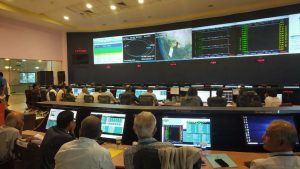 NewDelhi: The second de-orbiting manoeuvre for Vikram Lander of Chandrayaan-2 spacecraft was performed successfully on Wednesday, according to the Indian Space Research Organisation (ISRO). The ISRO informed that the manoeuvre began at 3.42 am (IST) as planned, using the onboard propulsion system. The total duration was nine seconds.
NewDelhi: The second de-orbiting manoeuvre for Vikram Lander of Chandrayaan-2 spacecraft was performed successfully on Wednesday, according to the Indian Space Research Organisation (ISRO). The ISRO informed that the manoeuvre began at 3.42 am (IST) as planned, using the onboard propulsion system. The total duration was nine seconds.
The orbit of Vikram Lander is 35 km x 101 km. Chandrayaan-2 Orbiter continues to orbit the Moon in an orbit of 96 km x 125 km and both the Orbiter and Lander are healthy. With this manoeuvre, the required orbit for the Vikram Lander to commence its descent towards the surface of the Moon is achieved.
The Lander is scheduled to powered descent between 1 am to 2 am (IST) on September 7, which will then be followed by touch down of Lander between 1.30 am and 2.30 am (IST). The separation of the Vikram Lander from Chandrayaan-2 Orbiter took place on Monday at 13.15 pm (IST). The Pragyan rover is a 6-wheeled and AI-powered vehicle. The name Pragyan translates to ‘wisdom’ in Sanskrit. It has been integrated within the lander.
The health of the Orbiter and Lander is being monitored from the Mission Operations Complex (MOX) at ISRO Telemetry, Tracking and Command Network (ISTRAC) in Bengaluru with support from Indian Deep Space Network (IDSN) antennas at Bylalu, near Bengaluru. All the systems of Chandrayaan-2 Orbiter and Lander are healthy.
The final manoeuvre of Chandrayaan 2 happened on Sunday evening. ISRO chairman Dr K Sivan has noted that the parameters of the orbiter, lander, rover are in good condition.
It may be recalled that the fourth Lunar bound orbit manoeuvre for Chandrayaan-2 was performed successfully on Friday using the onboard propulsion system of the spacecraft. The duration of the manoeuvre was 1155 seconds.
Chandrayaan-2 managed to successfully enter the Moon’s orbit on the morning of August 20 and ISRO had later released a statement confirming the Lunar Orbit Insertion of Chandrayaan-2 at 9.02 am.
Chandrayaan-2 was launched from Satish Dhawan space centre in Sriharikota in Andhra Pradesh by India`s heavy-lift rocket Geosynchronous Satellite Launch Vehicle-Mark III (GSLV Mk III) on July 22. The successful launch was carried out exactly a week after the ISRO had aborted the launch on July 15, just 56 minutes before the launch due to a “technical snag”.
The success of this mission will make India only the “fourth nation after the United States, China, and Russia to make a soft-landing on the lunar surface and the first nation to do so on the south pole of the lunar surface.
The mission includes four components: a GSLV Mk-III, an orbiter, a lander; and the small rover.
Bureau Report
Leave a Reply